Nevada hunting curtailed as excessive snow, extreme drought diminish mule deer, bighorn sheep herds

The frustration is hard to hide on Cody Schroeder’s face as the wildlife biologist steers his pickup off Interstate 80 and into the Carson Range to monitor mule deer habitat.
A once-bushy and tree-covered mountainside near Verdi is bisected by construction access roads, flat patches of dirt piled high with boulders that have been cleared out to level the steep slopes.
“This is kind of crazy, just how this has changed since I was out here just a few days ago,” says Schroeder, a staff biologist with the Nevada Department of Wildlife. “What we’re driving through is winter range for mule deer — or what used to be winter range for mule deer.”
The mountainside is slated for somewhere between 3,000 and 4,000 houses by luxury homebuilder Toll Brothers.
“Just seeing these trucks, it crushes my spirit,” Schroeder says as he navigates his truck up a dirt road and past men huddled around a pickup, a bulldozer parked off to one side. “It’s hard to be optimistic as a wildlife biologist in 2023.”
The number of mule deer across Nevada plummeted this year as the deer, weakened by two years of successive drought, struggled to find food sources during one of the snowiest winters on record and the sheep battle widespread disease.
Both biologists and hunters alike are watching populations to see if they will continue their downward trajectories — a highly possible situation considering development and erratic weather conditions across Nevada — or if they will rebound.
On April 15 — historically when areas are likely to have their peak snowpack — watersheds across the state were reporting anywhere from two to five times their usual median snowpack. The Snake River Basin that extends from Idaho into northeastern Nevada had nearly twice its median snowpack while the Carson River Basin in eastern California and western Nevada had more than three times its median snow level. Southern Nevada’s Spring Mountains had more than 500 percent of their median snowpack.
That thick snow hampered the ability of mule deer to forage. Not only were high-elevation summer ranges buried under snow, but, this winter, low-elevation ranges, like the soon-to-be housing development Schroeder was visiting, were too.
Fall surveys of the deer showed promising numbers for mule deer: For every 100 does, there were roughly 31 bucks and 54 fawns. But as the snowy winter raged on, the numbers turned. Mule deer monitored by the department during December, February and March had exceptionally low body fat reserves, and most herds saw a fawn loss of between 40 percent and 55 percent over the winter.
Now, only around 68,000 mule deer are roaming Nevada, the fewest in the state in nearly five decades, according to Schroeder.
During the 1990s, roughly 200,000 mule deer populated the state.
The area Schroeder is driving through, southwest of Northern Nevada’s Peavine Mountain, once hosted anywhere between 4,000 and 5,000 mule deer in the winter. Now, biologists are lucky if they spot 1,000.
“They’re kind of a canary in a coal mine, like the sage grouse,” he says. “They don’t just provide things for recreationalists to look at and people to hunt. They are very much part of the ecosystem.”
Adult mule deer mortality was also well above average, especially in herds around the Ruby Mountains. Roughly 50 percent of Nevada’s deer population is in three major herds in Elko County, and those herds saw roughly 5,000 deer die off over the winter.
In Elko County, sprawling housing developments at low elevations aren’t a problem like they are in Washoe County — instead, large-scale mines and renewable energy projects cut across prime winter habitat and migratory corridors.
“They have the same issues out there, just from a different source,” Schroeder says.
Desert bighorn sheep across Nevada are also struggling. The population is about 7,100, down from more than 10,000 between 2017 and 2019.
The alarming drop in sheep numbers stems from a number of factors, according to the department — like the mule deer, the cumulative effects of the drought and a loss of habitat and water sources have taken their toll. The sheep are also vulnerable to diseases spread by domestic livestock, and Nevada’s desert bighorns have seen an uptick in lamb and adult mortality from respiratory diseases.
The past two summers saw Southern Nevada’s bighorns “trapped, trying to find water,” says Mike Cox, staff biologist with NDOW. “We physically had animals dying of thirst.”

Declining numbers mean fewer hunting tags
The declining numbers are a problem for Nevada hunters, who are seeing an increase in applications for tags and a decrease in the number that are issued.
During the past 11 years, an average of 300 bighorn ram tags were issued annually. This year, just 234 tags are being issued, the largest single-year drop in the history of Nevada desert bighorn ram hunting.
Nevada is one of the most sought-after states for desert bighorn sheep and historically has offered more ram tags than any other Western state, according to Schroeder.
And just under 11,000 tags are being issued for mule deer this year, a 40 percent reduction over the amount issued in 2022. The number of tags NDOW issues for mule deer has declined steadily since 2012, when more than 24,000 were issued.
But as the number of tags issued has gone down as wildlife has battled extreme climate fluctuations and development, the department has seen an increase in tag applications.
Over 85,000 people submitted 432,000 tag applications this year; in 2018, roughly 70,000 people submitted 269,000 applications.
“There will be small recoveries,” Cox says. “But other than pronghorn and elk that can hold their own, mule deer and bighorn are going to continue to suffer.”
This story was updated at 8:45 a.m. on 6/21/23 to clarify numbers on hunting tag applications.
